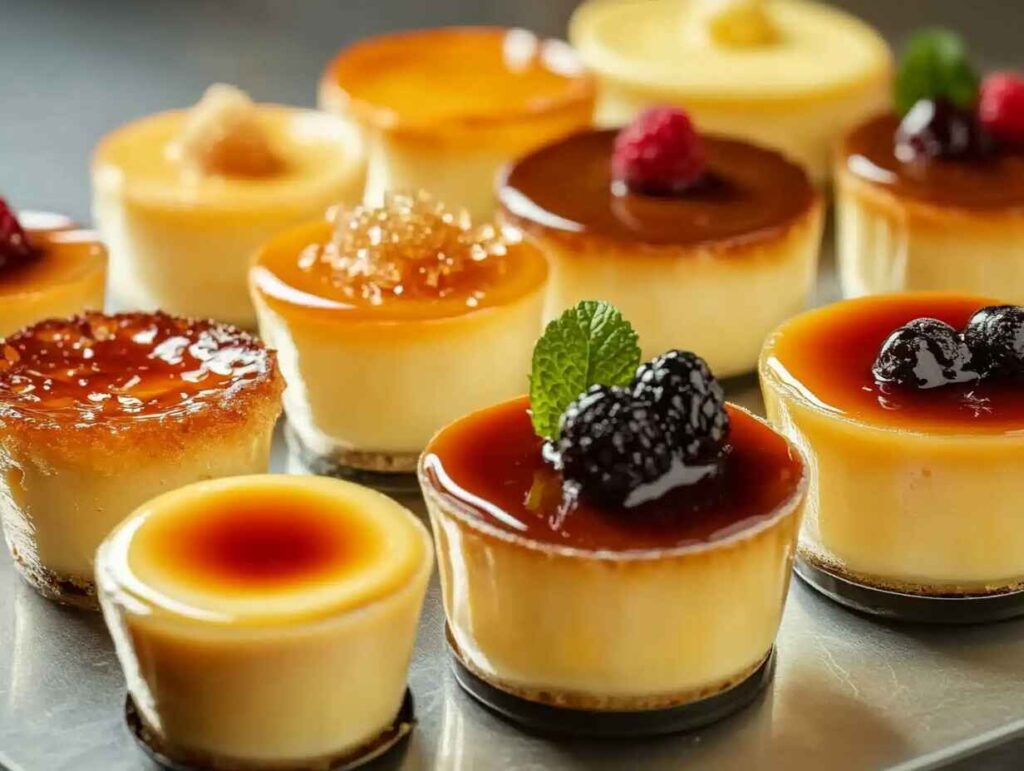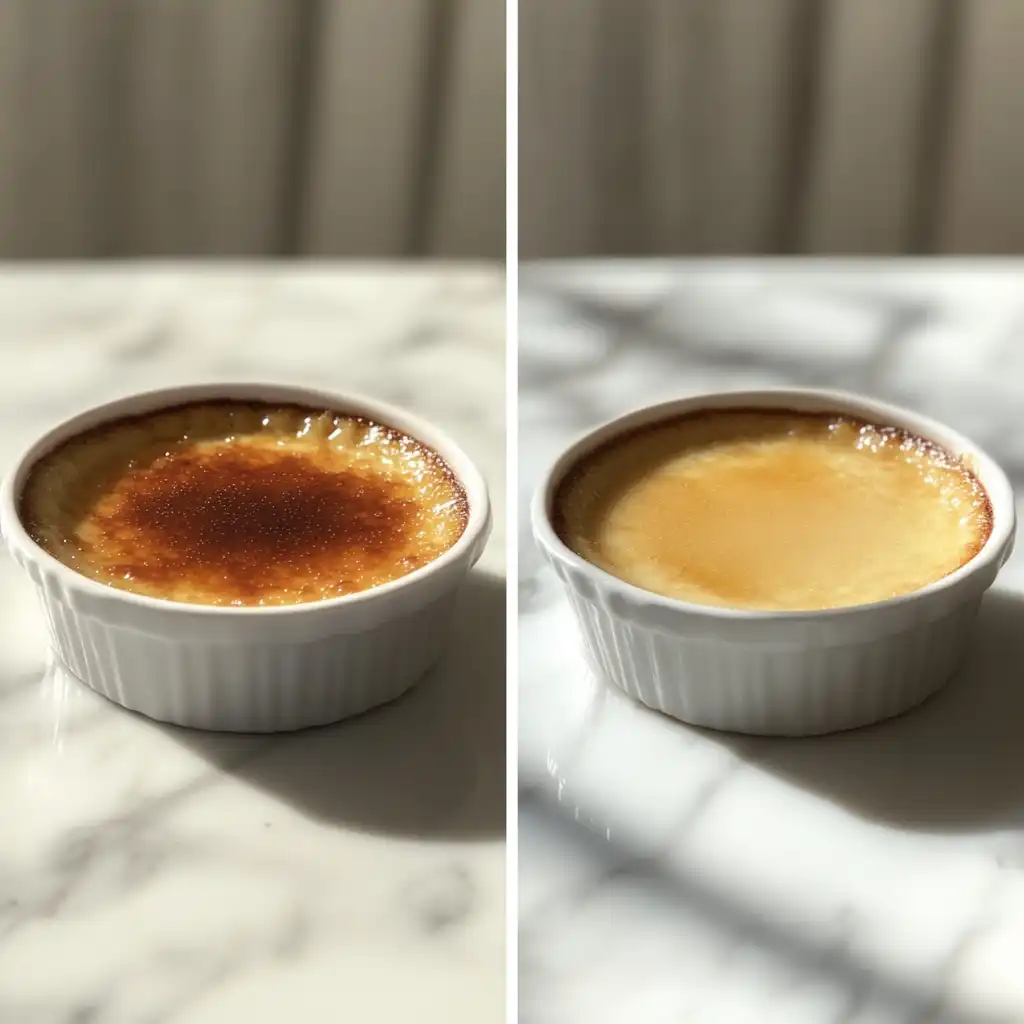Crème brûlée and custard are two timeless desserts that delight taste buds across the globe. Both share a foundation in dairy and eggs, offering creamy textures and rich flavors. Yet, these desserts are often confused with one another due to their similarities. This article explores their key differences, origins, and appeal, helping you understand when to enjoy each. By the end, you’ll have a clear grasp of what sets crème brûlée apart from custard, and why both deserve a spot on your dessert menu.
Table of Contents
What is Crème Brûlée?
Crème brûlée, which translates to “burnt cream” in French, is an elegant and luxurious dessert that has become synonymous with fine dining. If you’re curious about its foundational ingredients, visit What is Crème Brûlée made of? Its origins date back to the 17th century, though its precise beginnings are a topic of debate among culinary historians. Regardless of its origin, crème brûlée has earned its place as a dessert that satisfies both the palate and the eye.
Ingredients and Preparation Process
Crème brûlée combines heavy cream, egg yolks, sugar, and vanilla to create a decadent baked custard dessert. The process begins by mixing these ingredients to form a custard base. You then pour the mixture into ramekins and place them in a water bath, ensuring gentle, even cooking that prevents curdling and achieves the dessert’s signature creamy texture.
After baking and chilling the custard, you top it with a thin layer of sugar. Using a kitchen torch or broiler, you caramelize the sugar, creating a crispy, glass-like crust that contrasts beautifully with the creamy custard beneath.
The Caramelized Sugar Crust
The most distinguishing feature of crème brûlée is its caramelized sugar crust. To learn how to create this perfect golden topping, check out How to Caramelize Crème Brûlée: Tips for a Golden Crust. This element not only adds a delightful crunch but also introduces a subtle bitterness that balances the dessert’s sweetness. Breaking through the crust with a spoon is an iconic moment that adds to the sensory experience of enjoying this dessert.
Variations and Presentation Styles
The classic crème brûlée highlights vanilla as its primary flavor, but chefs frequently experiment with other ingredients to create exciting variations. Many add flavors like citrus zest, coffee, chocolate, or liqueurs such as Grand Marnier. Modern recipes sometimes include matcha or lavender for a unique twist.
Chefs traditionally serve crème brûlée in shallow ramekins to maximize the surface area of its caramelized crust. They often garnish the dessert with fresh berries, edible flowers, or a dusting of powdered sugar to enhance its visual appeal.

What is Custard?
Custard stands out as a versatile and widely beloved dessert with a rich history spanning cultures and cuisines. If you want to compare its flavor and sensory appeal to crème brûlée, explore What Does Crème Brûlée Taste Like?. It combines milk or cream, eggs, and sugar, cooked gently to create a smooth, creamy texture. Its adaptability has cemented its place in both sweet and savory dishes.
Basic Ingredients and Preparation Methods
Custard builds its foundation on three main ingredients: milk (or cream), eggs, and sugar. Chefs mix these components and heat them carefully, allowing the egg proteins to coagulate and thicken the mixture. Depending on the preparation, custard can range from silky and pourable to firm and sliceable.
While many recipes flavor custards with vanilla, some incorporate spices like nutmeg or cinnamon, fruits, or chocolate. Bakers often add cornstarch or flour to stabilize the mixture, especially when making thick custards or fillings.
Types of Custard
Custards vary primarily by their cooking method, which defines their texture and use. The three most common types include:
- Baked Custard: Cooks prepare baked custards in a water bath and bake them in the oven. These custards, such as flan, crème caramel, and traditional custard tarts, have a firm texture.
- Stirred Custard: Cooks heat stirred custards on the stovetop while stirring continuously. This method creates a smooth, pourable texture, as seen in pastry cream used for desserts like éclairs and cream puffs.
- Steamed Custard: This type, common in Asian cuisines, cooks in a steamer or over boiling water. It often includes savory flavors, like the egg custard found in Chinese dim sum.
Historical and Cultural Significance
Custard has been enjoyed for centuries, with early versions appearing in medieval European cuisine. It was often used as a filling for pies and tarts, and its versatility allowed it to become a key ingredient in countless recipes. Around the world, custard has taken on unique cultural adaptations, such as Portuguese pastéis de nata or Japanese purin.
Custard’s ability to blend seamlessly with other flavors and ingredients has kept it a timeless classic. Its universal appeal makes it a favorite for desserts, snacks, and even main dishes in some cuisines.
Key Differences Between Crème Brûlée and Custard
While crème brûlée and custard share a similar foundation of eggs, sugar, and dairy, they diverge in several key ways. These differences lie in their texture, flavor profile, preparation methods, and presentation, making each dessert uniquely appealing.
Texture and Consistency
The texture is one of the most noticeable differences between crème brûlée and custard.
- Crème Brûlée: Its baked custard base is creamy and slightly firm, but what truly sets it apart is the contrasting texture provided by the caramelized sugar crust. The combination of the smooth custard and crunchy topping creates a delightful sensory experience.
- Custard: Depending on the type, custard can range from pourable and silky (like crème anglaise) to thick and solid (like pastry cream or baked custards). Custards without a crust have a more uniform texture throughout.
Flavor Profile
Both desserts are rich and sweet, but their flavor profiles differ due to their preparation methods and additional elements.
- Crème Brûlée: The caramelized sugar crust introduces a subtle smokiness and a hint of bitterness that balances the sweetness of the custard. This interplay of flavors makes crème brûlée more complex.
- Custard: Custard’s flavor is often mild and straightforward, allowing it to serve as a versatile base for other desserts. It pairs well with fruits, syrups, and spices, adapting to various recipes and cuisines.
Cooking Techniques
The preparation of crème brûlée and custard involves distinct techniques, even though both are based on careful cooking of eggs and dairy.
- Crème Brûlée: This dessert is baked in a water bath to ensure even cooking. Once set and chilled, it undergoes a final step where sugar is caramelized on top, either with a torch or under a broiler. This step is unique to crème brûlée.
- Custard: Custard preparation varies widely depending on the type. Stirred custards require constant stirring over low heat, while baked custards rely on slow oven cooking. Some custards, like flan, involve an additional caramel layer but lack the signature crunch of crème brûlée’s sugar crust.
Appearance and Presentation
The visual presentation of these desserts further highlights their differences.
- Crème Brûlée: Its hallmark is the golden, glassy sugar crust. Served in shallow ramekins, it often includes minimal garnishes to let its simplicity shine.
- Custard: Custard’s appearance is highly variable. Pastry creams and flans may feature a glossy finish, while custards like crème anglaise are often unadorned, served as a complement to other desserts. Its diversity in form makes it visually adaptable to different culinary contexts.
Culinary Purpose and Versatility
Crème brûlée is typically a standalone dessert, prized for its luxurious texture and dramatic crust-breaking moment. Custard, on the other hand, is more versatile. While it can be enjoyed on its own, it frequently serves as a component in layered desserts, pastries, or as a filling.
Common Misconceptions
Crème brûlée and custard are often mistakenly thought of as interchangeable due to their shared ingredients and creamy textures. However, several misconceptions persist about their relationship and distinct characteristics. Let’s address some of the most common ones.
Is Crème Brûlée a Type of Custard?
The short answer is yes, but it’s more nuanced. Crème brûlée is a specific type of baked custard that incorporates a caramelized sugar topping. While it belongs to the broader category of custards, not all custards can be classified as crème brûlée. For instance, stirred custards like crème anglaise or thick pastry creams used in desserts like éclairs differ significantly in preparation and purpose.
Thus, while all crème brûlée is custard, not all custards are crème brûlée.
Overlapping Characteristics and Distinctions
Another misconception is that crème brûlée and custard are identical because they use similar ingredients. While the base ingredients eggs, sugar, and cream or milk are consistent, the preparation methods and end results vary. Crème brûlée’s caramelized crust is a defining characteristic that sets it apart from other custards. Similarly, custard encompasses a wide variety of textures and uses that go far beyond the scope of crème brûlée.
How Regional Variations Can Blur the Lines
Cultural variations in custard-based desserts can sometimes make it hard to differentiate between crème brûlée and other dishes. For example:
- Crème Caramel: Often confused with crème brûlée, this baked custard dessert features a layer of liquid caramel rather than a hard sugar crust.
- Flan: In some regions, flan is considered synonymous with crème caramel, while in others, it refers to a completely different dish.
- Puddings: In American cuisine, the term “custard” is sometimes used interchangeably with “pudding,” even though traditional custard relies on eggs as a thickener, while puddings often use cornstarch or gelatin.
These regional interpretations highlight the versatility of custards but also contribute to the confusion between crème brûlée and other custard-based dishes.
Assumptions About Flavor Profiles
Some people mistakenly believe crème brûlée is always sweeter or richer than other custards. In truth, the flavor balance of both desserts depends on the recipe. Crème brûlée may have a slight edge in complexity due to its caramelized topping, but custards can be equally indulgent when infused with ingredients like chocolate, citrus, or exotic spices.
Misconceptions About Difficulty Levels
Another myth is that crème brûlée is significantly harder to prepare than other custards. While its sugar-crusting step does require a bit of skill, the base custard is relatively simple to make. On the flip side, some custards, especially pastry creams, demand precision and constant attention to achieve the correct consistency. Therefore, the perceived complexity often depends on the cook’s familiarity with the respective techniques.
How to Choose Between Crème Brûlée and Custard
Deciding between crème brûlée and custard depends on personal preferences, the occasion, and even dietary needs. Understanding their unique qualities can help you make the perfect choice for your next dessert.
Preferences for Sweetness, Texture, and Richness
Your palate plays a significant role in determining which dessert is more suitable:
- Crème Brûlée: Ideal for those who enjoy a combination of textures creamy custard contrasted with a crunchy sugar crust. Its slightly caramelized flavor adds complexity, making it a favorite for those seeking a balanced sweetness with a touch of sophistication.
- Custard: Perfect for those who prefer a smoother, more consistent texture. Whether light and silky like crème anglaise or rich and thick like pastry cream, custard offers versatility in sweetness and flavor.
Occasions Where One is Preferred Over the Other
Different settings call for different desserts:
- Crème Brûlée: Best suited for formal dinners, celebrations, or special occasions where presentation matters. Its dramatic sugar crust and individual serving style make it a show-stopping dessert.
- Custard: Custard is a more versatile choice, fitting for both casual meals and elaborate desserts. Use it as a standalone treat, a filling for pastries, or a base for other creations like trifle or ice cream.
Dietary Considerations
When making a choice, dietary needs and ingredient considerations should also be factored in:
- Crème Brûlée: Its rich ingredients heavy cream and egg yolks make it a calorie-dense option. While indulgent, it may not suit those seeking lighter desserts. However, alternative recipes using lighter dairy options can be explored.
- Custard: Custards can be tailored to various dietary needs. For example:
- Low-Calorie Versions: Skim milk or plant-based milk can replace full-fat dairy.
- Vegan Custards: Coconut milk, almond milk, or oat milk with cornstarch or agar-agar can replicate the creamy consistency without eggs or dairy.
Customizing Flavors for Variety
Both desserts offer opportunities for creative variations:
- Crème Brûlée: Infuse the custard base with flavors like coffee, matcha, or lavender for a gourmet twist. Toppings like flavored sugars or fresh fruit can elevate the experience.
- Custard: Customize custards by incorporating seasonal fruits, spices, or liqueurs. Use it as a base for inventive desserts, like a layered parfait or a rich tart filling.
Ease of Preparation
Consider the effort involved in preparation:
- Crème Brûlée: While its sugar-crusting step may intimidate beginners, the custard base is straightforward to prepare. The use of a kitchen torch adds a dramatic touch but requires practice.
- Custard: Custards can be easier to prepare, especially stirred custards that don’t require baking or specialized tools. However, ensuring the right consistency may demand careful attention.
Storage and Shelf Life
Both desserts have specific storage considerations:
- Crème Brûlée: Best enjoyed fresh, as the sugar crust may lose its crunchiness if refrigerated for too long after caramelization. It can be prepared in advance, with the sugar topping added just before serving.
- Custard: Can often be stored longer, making it a practical option for meal planning. Depending on the type, it can be refrigerated for a few days or even frozen for later use in other recipes.
FAQs
Here are answers to some frequently asked questions about crème brûlée and custard to deepen your understanding of these two beloved desserts.
Can crème brûlée be made with regular custard?
Technically, you can use a custard base to make crème brûlée, as they share similar ingredients. However, the custard used for crème brûlée is slightly thicker and richer, often made with heavy cream and a higher proportion of egg yolks. To achieve the classic texture and taste of crème brûlée, it’s best to follow a recipe specifically designed for it, including the final caramelization step.
What makes crème brûlée’s crust unique?
The caramelized sugar crust of crème brûlée is its most iconic feature. It’s achieved by sprinkling a thin layer of sugar over the chilled custard and using a kitchen torch (or broiler) to melt and brown the sugar. This process creates a thin, glass-like crust that contrasts perfectly with the creamy custard underneath. The distinct crackling sound when breaking the crust adds to its sensory appeal.
Are there vegan alternatives for either dessert?
Yes, vegan versions of both desserts can be made using plant-based ingredients.
- For Crème Brûlée: Substitute heavy cream with coconut cream or cashew milk, and use agar-agar or cornstarch instead of eggs to thicken the custard. The sugar crust can be caramelized as usual.
- For Custard: Replace milk with almond, oat, or soy milk, and use a starch-based thickener like cornstarch or tapioca flour instead of eggs. Vegan custards can be flavored and used in similar ways as their traditional counterparts.
How do the cooking times differ between the two?
- Crème Brûlée: Baking time for crème brûlée ranges from 30–40 minutes, depending on the oven temperature and ramekin size. The sugar caramelization step adds a few extra minutes before serving.
- Custard: The cooking time varies widely depending on the type of custard. Stirred custards cook relatively quickly on the stovetop, taking about 10–15 minutes. Baked custards may require 25–50 minutes, while steamed custards often cook within 20–30 minutes.
What are some creative custard recipes?
Custard’s versatility makes it an excellent base for inventive recipes. Some creative options include:
- Layered Custard Parfaits: Alternating layers of custard with fresh fruit and granola for a refreshing dessert.
- Chocolate Custard Tart: A decadent tart filled with chocolate custard and topped with whipped cream or berries.
- Savory Egg Custards: Adding cheese, vegetables, or herbs to create a savory dish, popular in Asian and European cuisines.
Can crème brûlée be served without its crust?
While the caramelized sugar crust is a defining feature of crème brûlée, it is technically possible to serve it without the crust. However, doing so transforms it into a baked custard similar to a pot de crème. The sugar crust not only adds a textural element but also balances the dessert’s sweetness, so omitting it may result in a less dynamic flavor profile.
Conclusion
Crème brûlée and custard are two desserts that share a common foundation but offer distinctly different experiences.Crème brûlée captivates with its dramatic sugar crust and luxurious texture, while custard shines in its adaptability and versatility. To discover more about their unique qualities, browse The Difference Between Crème Brûlée and Custard and dive deeper into their culinary charm.
Understanding their differences in texture, flavor, preparation, and presentation allows you to appreciate each dessert’s unique charm. Whether you’re indulging in the crunch of a perfectly caramelized crème brûlée or savoring a spoonful of creamy custard, both desserts have earned their place as timeless culinary favorites.
Next time you’re faced with the choice, consider your cravings, the occasion, and the experience you wish to create. One thing is certain whether you choose crème brûlée or custard, you’ll be in for a treat.

